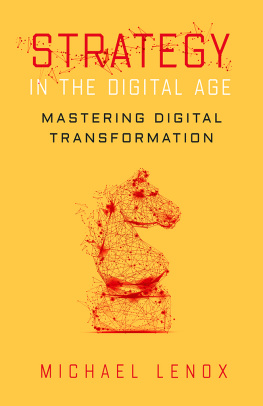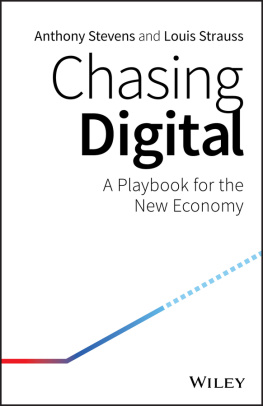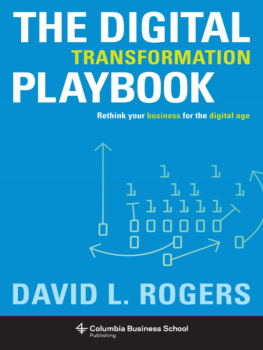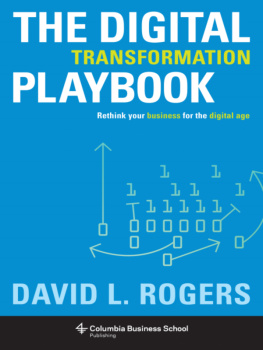STRATEGY IN THE DIGITAL AGE
MASTERING DIGITAL TRANSFORMATION
MICHAEL LENOX
STANFORD BUSINESS BOOKS
Stanford, California
Stanford University Press
Stanford, California
2023 by Michael James Hale Lenox. All rights reserved.
No part of this book may be reproduced or transmitted in any form or by any means, electronic or mechanical, including photocopying and recording, or in any information storage or retrieval system without the prior written permission of Stanford University Press.
Special discounts for bulk quantities of Stanford Business Books are available to corporations, professional associations, and other organizations. For details and discount information, contact the special sales department of Stanford University Press. Tel: (650) 725-0820, Fax: (650) 725-3457
Printed in the United States of America on acid-free, archival-quality paper
Cataloging-in-Publication Data available upon request.
Library of Congress Control Number: 2022037728
ISBN: 9781503635197 (cloth), 9781503635760 (ebook)
Cover designer: Kevin Barrett Kane
Cover illustration: Adobe Stock
To my children, Ben and Haley, digital natives who are
navigating this brave new age
Contents
Figures
Preface
The digital age is upon us. Digital technology is having an impact on virtually every endeavor in our lives. From the constant presence of our mobile devices to the ubiquity of social media to digitally enabled everyday objects such as our cars, appliances, and watches, the digital age is inescapable. Each transaction and engagement in this digital world generates massive amounts of data that when combined with advanced analytics such as machine learning and artificial intelligence manifest opportunities for creating value for stakeholders in new and transformational ways. They also raise numerous ethical and legal concerns that cannot be avoided and require purposeful attention.
To say that navigating the digital age is fraught with peril is an understatement. I have not found an industry or sector that is not feeling the pressure to digitally transform. Most companies and organizations that I talk and work with are afraid of being digitally disrupted. They are faced with evolving or going extinct. Big tech companies have built powerful platforms that they are leveraging to enter and, in many cases, dominate adjacent sectors. No sector is immune. Finance, energy, manufacturing, media, consumer goods, agriculture, all feel the pressure to transform. The criticality of data and analytics is fundamentally reshaping markets and leading to winner-take-all dynamics in many industries. The list of venerable companies left behind in the wake of digital disruption grows every day.
Strategy in the Digital Age is designed to help businesses and organizations navigate this brave new world. First and foremost, this book is aimed at those undertaking a digital transformation at their organization or who are simply looking to be more savvy strategic thinkers in the digital age. To be clear, this book is about strategy. We do not take deep dives explaining the intricacies of machine learning algorithms or how to set up a blockchain. This book is not aimed at IT professionals looking for the specifics of building a data lake or migrating to the cloud. There are numerous resources out there that can provide detailed guidance on these topics. This book is about looking at the big picture.
A common theme throughout this book is that digital technology is changing the underlying basis of competition for a wide swath of businesses and industries. Digital transformation is much more than building a digital infrastructure to gather and process data (though this remains critical). It is about understanding how digital technologies enable the creation of innovative value-added services and products. It is about how new competitive positions and business models are possible in the digital age and how to think critically about how to both create and capture value. Most important, this book is about how to lead a digital transformation in your organizationnot only paying attention to the technical details but also thinking through the human dimension and being sophisticated about the numerous social and policy challenges raised by digital technology.
Strategy in the Digital Age is based on my second-year MBA elective of the same name that I have been teaching for several years at the University of Virginias Darden School of Business. I am incredibly grateful to my students who have served as beta testers for this material and who have provided extremely valuable feedback that has greatly improved the final project. I also want to thank my partners at the Boston Consulting GroupAmane Dannouni, Ching Fong Ong, and Sonja Ruegerwhom I collaborated with on an online course from Coursera titled Digital Transformation. I want to thank the numerous executives and companies that I have worked with, either as a consultant or through Dardens Executive Education and Life-Long Learning operation. Your willingness to share both your successes and struggles has been critical to my thinking on the topic.
In undertaking this project, I also benefited greatly from the writings of and my interactions with my colleagues at the Darden School and beyond. I have been studying, researching, and teaching about technology and disruption for over a quarter century. I thank my previous coauthors, Gary Dushnitsky at London Business School, Chuck Eesley at Stanford University, Andy King at Boston University, and Scott Rockart at Duke University, who have profoundly shaped my thinking on disruption. In my research for this book, the recent works of Nicolaj Siggelkow and Christian Terwiesch at the Wharton School of Business, Marco Iansiti and Karim Lakhani at the Harvard Business School, Ajay Agrawal, Joshua Gans, and Avi Goldfarb at the University of Toronto, and Ron Adner at Dartmouth University, among many others, have contributed to my own thinking on the topic. I have benefited greatly from my wonderful colleagues at the Darden School of Business including, but not limited to, Alex Cowan, Ed Freeman, Yael Grushna-Cockayne, Jared Harris, Ed Hess, Jeanne Liedtka, Bobby Parmar, Saras Sarasvathy, Scott Snell, Raj Venkatesan, and Venkat Venketaraman.
This book would not have been possible without the assistance of my coauthor and colleague Becky Duff, who graciously agreed to help with fact checking and citations. The figures in this book were designed by Leigh Ayers. Thanks to Steve Catalano and the entire team at Stanford University Press for their enthusiasm and guidance. I also thank my external reviewers. I greatly appreciate your suggestions and feedback. I would like to acknowledge the support of the Darden School and the Batten Institute for Innovation and Entrepreneurship. A special thanks to Kush Arora, Dardens Chief Digital Officer, who has been helping lead Dardens digital transformation efforts and has taught me so much about data lakes, business intelligence software, dashboards, and, most important, how to effectively manage a transformation.
Last, I wish to thank my family. My two children were born soon after the dot-com era. Google, Facebook, Uber, Airbnb, Tesla, TikTok, and hundreds of other digital disruptors have risen during their lifetimes. As they have grown up, we have had to navigate mobile devices, social media, streaming media, and online learning. Questions of screen time, online presence, data privacy, cyberbullying, and cybersecurity are constant conversations. The digital age is stressful, especially for parents. I am thankful to have been traversing these disruptive times with my wife and kids. Their support, insights, and desire to be good digital citizens inform and inspire me every day.







